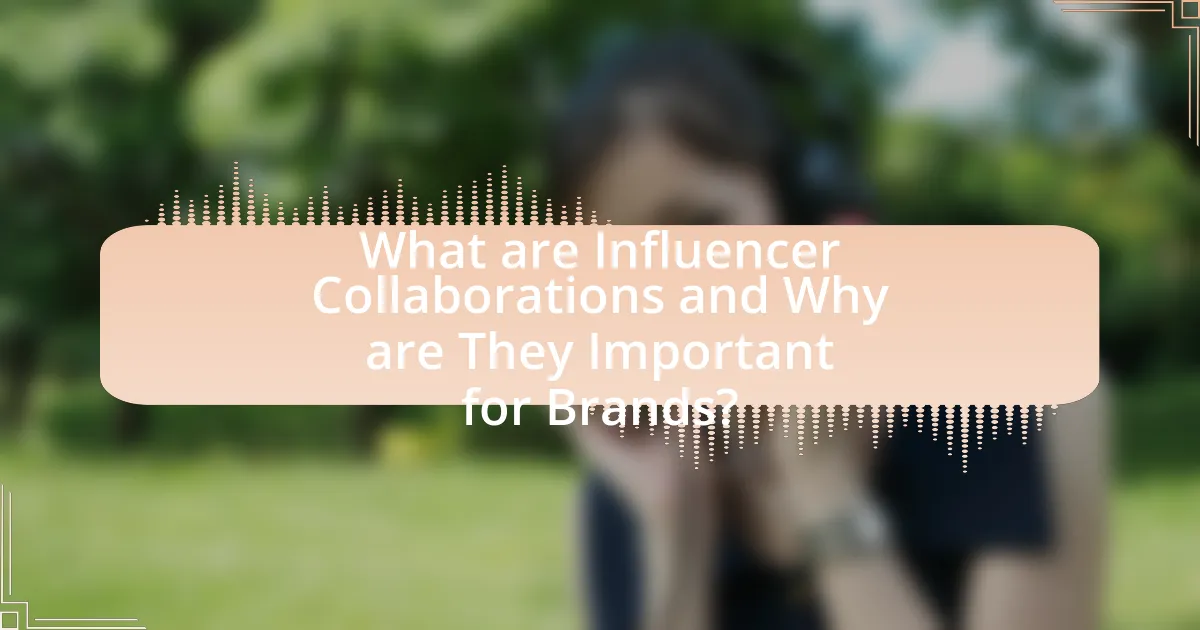Influencer collaborations are strategic partnerships between brands and social media influencers aimed at promoting products or services. These collaborations are crucial for enhancing brand visibility, building trust, and driving consumer engagement, as 49% of consumers rely on influencer recommendations. The article explores the mechanics of influencer marketing, types of influencers, strategies for selecting the right partners, and the benefits of these collaborations. It also addresses challenges brands may face, such as misalignment of values and measuring ROI, while highlighting future trends and practical tips for maximizing the impact of influencer partnerships.

What are Influencer Collaborations and Why are They Important for Brands?
Influencer collaborations are partnerships between brands and social media influencers to promote products or services. These collaborations are important for brands because they leverage the influencer’s established audience and credibility, resulting in increased brand awareness and trust. According to a study by the Digital Marketing Institute, 49% of consumers depend on influencer recommendations, highlighting the effectiveness of this marketing strategy in reaching target demographics and driving consumer behavior.
How do Influencer Collaborations work in the context of brand marketing?
Influencer collaborations in brand marketing involve partnerships between brands and social media influencers to promote products or services. These collaborations leverage the influencer’s audience and credibility to enhance brand visibility and engagement. For instance, a study by the Digital Marketing Institute found that 49% of consumers depend on influencer recommendations when making purchasing decisions, highlighting the effectiveness of such partnerships. Brands typically select influencers whose values align with their own, ensuring authenticity in the promotion, which can lead to increased trust and conversion rates.
What types of influencers can brands collaborate with?
Brands can collaborate with various types of influencers, including mega influencers, macro influencers, micro influencers, and nano influencers. Mega influencers typically have over a million followers and can provide extensive reach, while macro influencers, with 100,000 to 1 million followers, offer a balance of reach and engagement. Micro influencers, who have between 1,000 and 100,000 followers, often boast higher engagement rates and niche audiences, making them effective for targeted campaigns. Nano influencers, with fewer than 1,000 followers, can foster strong community connections and authenticity, appealing to brands looking for grassroots marketing. This classification is supported by research indicating that micro and nano influencers often yield higher engagement rates compared to their larger counterparts, making them valuable for brands aiming for effective influencer marketing strategies.
How do brands identify the right influencers for their target audience?
Brands identify the right influencers for their target audience by analyzing audience demographics, engagement metrics, and content relevance. They utilize tools like social media analytics to assess the influencer’s follower base, ensuring alignment with their target market’s age, gender, location, and interests. Additionally, brands evaluate engagement rates, such as likes, comments, and shares, to gauge the influencer’s ability to connect with their audience. Research indicates that 70% of consumers are more likely to purchase a product when recommended by an influencer they trust, highlighting the importance of selecting influencers who resonate with the brand’s values and messaging.
What benefits do Influencer Collaborations provide for brands?
Influencer collaborations provide brands with increased visibility and access to targeted audiences. By partnering with influencers who have established trust and credibility within specific niches, brands can effectively reach potential customers who are more likely to engage with their products or services. According to a study by the Digital Marketing Institute, 49% of consumers depend on influencer recommendations, highlighting the effectiveness of these collaborations in driving consumer behavior. Additionally, influencer partnerships can enhance brand authenticity, as influencers often share personal experiences with products, leading to higher engagement rates and conversions.
How do these collaborations enhance brand visibility?
Collaborations with influencers enhance brand visibility by leveraging the influencers’ established audiences and credibility. When brands partner with influencers, they gain access to a wider demographic that may not have been reached through traditional marketing channels. For instance, a study by Nielsen found that 92% of consumers trust recommendations from individuals over brands, indicating that influencer endorsements can significantly boost brand recognition and trust. Additionally, influencer collaborations often result in increased engagement on social media platforms, further amplifying brand exposure through shares, likes, and comments.
What role do influencer collaborations play in building brand trust?
Influencer collaborations play a crucial role in building brand trust by leveraging the established credibility and authenticity of influencers. When brands partner with influencers who align with their values, they can effectively reach target audiences through trusted voices, enhancing perceived reliability. Research indicates that 70% of teenagers trust influencers more than traditional celebrities, highlighting the significant impact influencers have on consumer perceptions. This trust is further reinforced when influencers share genuine experiences with the brand, leading to increased consumer confidence and loyalty.

How can Brands Effectively Utilize Influencer Collaborations?
Brands can effectively utilize influencer collaborations by strategically selecting influencers whose audience aligns with their target market. This alignment ensures that the influencer’s followers are likely to be interested in the brand’s products or services, leading to higher engagement and conversion rates. For instance, a study by the Digital Marketing Institute found that 49% of consumers depend on influencer recommendations when making purchase decisions, highlighting the significant impact of influencer partnerships on consumer behavior. Additionally, brands should establish clear objectives for the collaboration, such as increasing brand awareness or driving sales, and measure the campaign’s success through metrics like engagement rates, reach, and return on investment. By focusing on these strategies, brands can maximize the effectiveness of their influencer collaborations.
What strategies should brands implement for successful influencer partnerships?
Brands should implement clear communication, alignment of values, and performance metrics for successful influencer partnerships. Clear communication ensures that both parties understand expectations, deliverables, and timelines, which minimizes misunderstandings and fosters collaboration. Aligning values between the brand and the influencer enhances authenticity, as consumers are more likely to trust endorsements that resonate with their beliefs. Establishing performance metrics, such as engagement rates and conversion tracking, allows brands to evaluate the effectiveness of the partnership and make data-driven decisions. Research indicates that brands with well-defined influencer strategies see a 37% higher ROI compared to those without structured approaches.
How can brands create compelling collaboration proposals for influencers?
Brands can create compelling collaboration proposals for influencers by clearly defining mutual benefits and aligning their goals with the influencer’s audience. A well-structured proposal should include specific campaign objectives, detailed deliverables, and a clear value proposition that highlights how the collaboration will benefit both parties. For instance, a study by Influencer Marketing Hub indicates that 63% of marketers believe that influencer collaborations can significantly enhance brand awareness, emphasizing the importance of a strategic approach. By presenting data-driven insights and tailored content ideas, brands can effectively engage influencers and foster successful partnerships.
What are the best practices for managing influencer relationships?
The best practices for managing influencer relationships include establishing clear communication, setting mutual expectations, and fostering genuine connections. Clear communication ensures that both parties understand campaign goals, deliverables, and timelines, which can lead to more effective collaborations. Setting mutual expectations helps in aligning the influencer’s content style with the brand’s messaging, thereby enhancing authenticity. Fostering genuine connections involves engaging with influencers beyond transactional interactions, such as supporting their content and sharing their work, which can lead to long-term partnerships. According to a study by the Digital Marketing Institute, brands that maintain strong relationships with influencers see a 37% increase in engagement rates, highlighting the importance of effective relationship management.
What metrics should brands track to measure the success of influencer collaborations?
Brands should track engagement rate, reach, impressions, conversion rate, and return on investment (ROI) to measure the success of influencer collaborations. Engagement rate indicates how well the audience interacts with the content, while reach and impressions provide insights into the visibility of the campaign. Conversion rate measures the effectiveness of the collaboration in driving desired actions, such as purchases or sign-ups. ROI quantifies the financial return relative to the investment made in the collaboration. According to a 2021 study by Influencer Marketing Hub, businesses earn an average of $5.78 for every dollar spent on influencer marketing, highlighting the importance of tracking these metrics for assessing collaboration success.
How can brands assess the return on investment (ROI) from influencer marketing?
Brands can assess the return on investment (ROI) from influencer marketing by measuring key performance indicators (KPIs) such as engagement rates, conversion rates, and overall sales attributed to the campaign. By tracking metrics like reach, impressions, and click-through rates, brands can quantify the impact of influencer collaborations on their marketing goals. For instance, a study by Influencer Marketing Hub found that businesses earn an average of $5.78 for every dollar spent on influencer marketing, highlighting the potential financial benefits. Additionally, using tools like Google Analytics can help brands attribute website traffic and sales directly to influencer campaigns, providing concrete data to evaluate ROI effectively.
What tools can brands use to analyze influencer campaign performance?
Brands can use tools like Google Analytics, Hootsuite, and Sprout Social to analyze influencer campaign performance. Google Analytics allows brands to track website traffic and conversions resulting from influencer campaigns, providing insights into user behavior and engagement. Hootsuite offers social media analytics that measure engagement metrics such as likes, shares, and comments, helping brands assess the impact of influencer posts. Sprout Social provides comprehensive reporting features that analyze audience growth and engagement, enabling brands to evaluate the effectiveness of their influencer partnerships. These tools collectively offer data-driven insights that help brands optimize their influencer marketing strategies.

What Challenges Might Brands Face in Influencer Collaborations?
Brands may face several challenges in influencer collaborations, including misalignment of values, lack of authenticity, and difficulty in measuring ROI. Misalignment occurs when the influencer’s audience or personal brand does not resonate with the brand’s target demographic, potentially leading to ineffective campaigns. Lack of authenticity can arise if influencers do not genuinely believe in the product, which can result in negative consumer perception. Additionally, measuring return on investment (ROI) can be complex, as brands often struggle to quantify the impact of influencer partnerships on sales and brand awareness. According to a survey by Influencer Marketing Hub, 49% of marketers cited measuring ROI as their biggest challenge in influencer marketing, highlighting the need for clear metrics and goals in these collaborations.
How can brands navigate potential pitfalls in influencer partnerships?
Brands can navigate potential pitfalls in influencer partnerships by conducting thorough research on influencers to ensure alignment with brand values and audience. This involves analyzing an influencer’s past collaborations, engagement rates, and audience demographics to confirm they resonate with the target market. For instance, a study by Influencer Marketing Hub in 2021 found that 63% of marketers cited influencer misalignment as a significant challenge, emphasizing the need for careful selection. Additionally, establishing clear communication and expectations from the outset can prevent misunderstandings and ensure that both parties are on the same page regarding deliverables and brand messaging.
What are common issues that arise during influencer collaborations?
Common issues that arise during influencer collaborations include misalignment of brand values, lack of clear communication, and unrealistic expectations. Misalignment occurs when the influencer’s audience or content style does not resonate with the brand’s target market, potentially leading to ineffective campaigns. Lack of clear communication can result in misunderstandings regarding deliverables, timelines, and compensation, which may hinder the collaboration’s success. Unrealistic expectations often stem from brands expecting immediate results or high engagement rates without considering the influencer’s typical performance metrics. These issues can significantly impact the effectiveness of influencer marketing efforts, as evidenced by studies showing that 60% of marketers cite miscommunication as a major barrier to successful collaborations.
How can brands ensure compliance with advertising regulations in influencer marketing?
Brands can ensure compliance with advertising regulations in influencer marketing by implementing clear guidelines and contracts that outline disclosure requirements. These contracts should specify that influencers must clearly label sponsored content, adhering to the Federal Trade Commission (FTC) guidelines, which mandate that endorsements must be disclosed to avoid misleading consumers. Additionally, brands should provide training for influencers on compliance standards and regularly monitor their content to ensure adherence. Research indicates that brands that actively engage in compliance practices reduce the risk of legal repercussions and enhance consumer trust, as evidenced by a 2021 study from the Journal of Advertising, which found that transparent influencer partnerships lead to higher audience engagement and brand credibility.
What are the future trends in influencer collaborations for brands?
Future trends in influencer collaborations for brands include a shift towards long-term partnerships, increased focus on authenticity, and the integration of technology such as augmented reality and artificial intelligence. Brands are moving away from one-off campaigns to establish ongoing relationships with influencers, which fosters deeper connections with audiences. Authenticity is becoming paramount, as consumers increasingly prefer influencers who genuinely align with their values and lifestyles. Additionally, the use of technology is enhancing engagement; for example, augmented reality filters and AI-driven content personalization are being utilized to create immersive experiences that resonate with target demographics. These trends are supported by data indicating that long-term collaborations can lead to a 37% increase in engagement rates compared to short-term partnerships.
How is technology shaping the landscape of influencer marketing?
Technology is significantly shaping the landscape of influencer marketing by enabling data-driven strategies and enhancing audience engagement. Advanced analytics tools allow brands to identify the most effective influencers based on audience demographics, engagement rates, and content performance, leading to more targeted marketing efforts. For instance, a study by Influencer Marketing Hub in 2022 revealed that 63% of marketers believe that data analytics is crucial for influencer selection, demonstrating the reliance on technology for informed decision-making. Additionally, platforms like Instagram and TikTok provide features such as shoppable posts and live streaming, which facilitate direct interaction between influencers and their followers, thereby increasing conversion rates. This integration of technology not only streamlines collaboration but also amplifies the impact of influencer campaigns, making them more measurable and effective.
What emerging platforms should brands consider for influencer collaborations?
Brands should consider platforms like TikTok, Clubhouse, and Twitch for influencer collaborations. TikTok has rapidly gained popularity, boasting over 1 billion monthly active users, making it a prime space for brands to engage with younger audiences through creative short-form videos. Clubhouse, with its audio-based format, allows brands to connect with consumers in real-time discussions, fostering a sense of community and authenticity. Twitch, primarily known for gaming, has expanded its reach to various content categories, attracting a diverse audience and offering brands unique opportunities for live interactions and sponsorships. These platforms are not only emerging but also demonstrate significant user engagement, making them effective for influencer marketing strategies.
What practical tips can brands follow to maximize the impact of influencer collaborations?
Brands can maximize the impact of influencer collaborations by selecting influencers whose audience aligns with their target market. This alignment ensures that the content resonates with potential customers, leading to higher engagement rates. Research indicates that 49% of consumers depend on influencer recommendations for purchasing decisions, highlighting the importance of choosing the right influencer. Additionally, brands should establish clear objectives for the collaboration, such as increasing brand awareness or driving sales, to measure success effectively. Utilizing authentic storytelling in campaigns can also enhance relatability, as 86% of consumers prefer brands that share genuine stories. Finally, maintaining open communication with influencers fosters a collaborative environment, allowing for creative input that can lead to more impactful content.